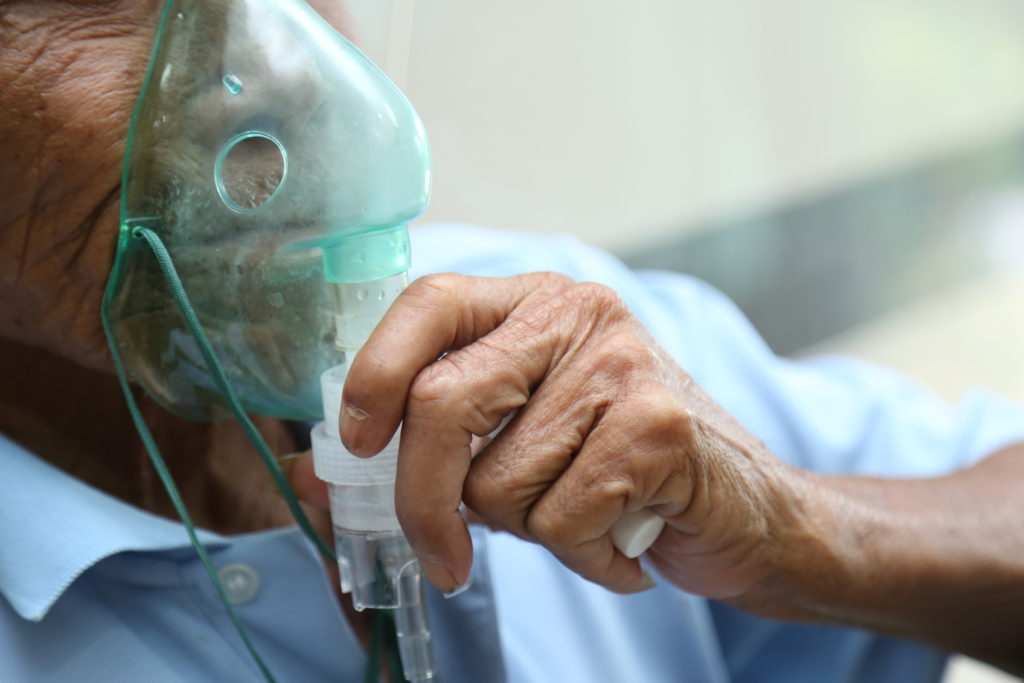When caring for a loved one with COPD, questions can arise surrounding how hospice care can help and knowing when it’s time to call in hospice. To help you navigate this difficult decision, we’ve put together a guide on how hospice can help COPD patients and signs to look out for to help you determine hospice eligibility for COPD patients.
What is COPD?
COPD stands for chronic obstructive pulmonary disease. It’s a chronic disease that damages the lungs and causes inflammation that inhibits airflow. Patients with COPD have less air flowing in and out of their lungs, making it difficult for them to breathe.
COPD is usually caused by repeated exposure to gases and particles that irritate the lungs, like cigarette smoke. Smoking cigarettes is the number one cause of COPD. Patients with COPD often live with bronchitis and emphysema, although the degree of severity varies from patient to patient.
Common Symptoms of COPD
Patients with COPD also have an increased risk of lung cancer and heart disease. Common symptoms of COPD include difficulty breathing, shortness of breath, persistent cough, excessive mucus production, tightness in the chest, wheezing, frequent respiratory symptoms, and low energy.
COPD symptoms typically present themselves after significant lung damage has already occurred. They usually develop slowly and get progressively worse over time. However, symptoms can be controlled so that those living with COPD still have a good quality of life.
The “shortness-of-breath-anxiety” vicious circle.
In the latter stages of COPD, shortness of breath worsens. Treatments that previously would work to improve SOB no longer work as well or even at all. This leads to anxiety about not being able to breath and increased heart rate, which leads to, you guessed it – increased shortness of breath! Its a vicious cycle that many patients in the latter stages of their disease experience. West Michigan Hospice understands this vicious cycle and how to manage it at home instead of the ER. Other modes of care can’t provide solutions to this circle.
How Can Hospice Care for COPD Help Patients?
When the decision has been made to begin hospice care for COPD patients, treatments focus on the comfort of the patient. These comfort-care services can include respiratory therapies to help the patient breathe easier, pain-relieving medications, and management of anxiety and depression.
Hospice services are individualized based on each patient’s needs. For example, the various respiratory therapies available to COPD patients include CPAP machines, cylinders, oxygen concentrators, and nasal cannulas and medications that improve work of breathing and stop the shortness of breath/anxiety circle. The medications that Hospice has access to is greater than other providers. The choice of which treatment to provide the COPD patient will be made by the hospice nurses based on what is best for each patient.
The comfort-providing services of hospice can be administered in nursing homes, assisted living facilities, or the patient’s home. Together with the hospice provider, patients and their families will develop a care plan individualized to the patient’s specific needs, addressing their desires for their end of life while also providing support for the family.
In addition to helping the patient feel more comfortable ihospice care can also support the families of COPD patients. Hospice aides can help with household chores and grocery shopping, while nurses and social workers facilitate difficult conversations between family members, and provide bereavement counseling.
How to Determine Hospice Eligibility for COPD Patients
Determining when to request hospice care for a loved one with COPD is a difficult and emotional decision. When your loved one is managing the symptoms of a chronic disease like COPD, the sooner hospice care is called in to provide comfort care, the better. This means the patient can be more comfortable in the end stages of the disease.
Hospice care is also recommended before the patient has reached the end-of-life stage. This ensures that the patient will be well taken care of and supervised by professionals who prioritize the patient’s comfort and quality of life.
Knowing what to look for when determining when to begin hospice care for COPD is crucial to keeping patients comfortable in their end stages of life. However, knowing when the patient’s symptoms have required hospice care can be difficult for families to determine.
To help you know what to look for, here are a few of the main signs of hospice eligibility for COPD patients:
- The use of oxygen becomes a requirement almost all of the time.
- Consistent shortness of breath occurs even when the patient has oxygen therapy and is at rest or with minimal exertion.
- The patient progressively becomes unable to perform daily tasks like bathing, eating, and going to the bathroom independently.
While the decision to call in hospice care for your loved one is difficult, it can ensure a good quality of life for the time we have left.
West Michigan Hospice is here for you.
Deciding to begin hospice care for your loved one is never easy. At West Michigan Hospice, our individualized care and personable staff comfort patients and their families. Our hospice nurses are here to help make the transition as smooth as possible, creating individualized treatment plans that address each patient’s unique needs.
West Michigan Hospice is here for you. To learn more about how we can provide for your loved one’s end-of-life care, give us a call or contact us online.

